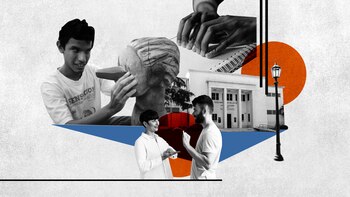
The Educational Area of the Castagnino+Macro Museum in Rosario is carrying out an artistic awareness project for blind people within the framework of a series of inclusive activities such as the production of audio guides, videos with sign languages and subtitles and other accessibility proposals at the two venues of the institution. One of the objectives is the production of prototypes and 3D printing of Antonio Berni's xylocollages belonging to the museum's collection. The plan is to have these works in 3D, palpable and tactile by June. For this, the museum works with the Movement for the Unity of the Blind and Amblyopes of Rosario (MUCAR).
Adapting works for the different groups that visit the museum — including people who are blind and visually impaired, deaf or with intellectual disabilities — has long been one of the objectives of the Education Area.

“We were always interested in inclusion. We began to become aware of a very important work from our collection that is widely exhibited in the room. Berni is a very important artist for both Rosarinos and all Argentines,” says Ángela Ríos, a member of that area.
“We received a beautiful response from all the visitors. We are very grateful and really enjoyed the meetings with them, the tours of the rooms, the talks and the discussions that followed,” he adds.
The five xylocollages that will have their 3D version are Juanito pescando (1962), Juanito fishing with net (1961), Juanito with fish (1961), Juanito hunting birds (1961) and Juanito bathing (1961). In 1962 the artist won the Grand Prize for Engraving and Drawing at the XXXI Venice Biennale with these works and ten other collages.
The work of the artist, who was born in Rosario in 1905 and completed his first studies in drawing at the Academy of Art of the Centre Catalá, is part of the institution's heritage thanks to the donation of Domingo Minetti and Gonzalo Martínez Carbonell, two art collectors from the city.
The participation of each group
The museum's accessibility program has different activities and devices. In order to adequately understand and address the uniqueness of each group, training was conducted with professionals and suitable institutions such as the Municipal Disability Department, the Circulo de Bordos, the Argentine Library and the aforementioned MUCAR.
In this way, the approach is always interdisciplinary. Over the years, a collaborative network was created to think, plan and design working methodologies according to the needs of each group.

“Although we already had texts in braille and audio descriptions of the works, we lacked this sensitive approach that has to do with the tactile journey,” says Ríos. “All this work cannot be done only from the institution, it must be done together, we need the perception of the collective,” explains Juliana Tomatis, also from the Museum's Educational Area.
“Participation and social inclusion are achieved not only by eliminating the building barriers imposed by our modern societies, but also by making heritage accessible through tools and devices focused on the expectations and needs of the public who visit us,” defines the museum on its website.
Florencia Cardú, another member of the educational team, believes that the biggest change in consciousness that needs to be made is “learning to understand the different ways of approaching works of art”. “These ways cannot be alien to us. It's a minute-by-minute job that requires a lot of listening,” he adds.
“When we made the videos with sign language, we learned, for example, to work in the backgrounds, not to cast shadows; we had to find a suitable light. The people we worked with, Romina and Eduardo from the Circle of the Deaf, were advising us. We also worked on the language of art to make it understandable, since there are no words in sign language”, says Ríos.

“Networking is key, both legs are needed. When you meet each of the communities, it is a learning experience for us to understand their needs. They are always very demanding and that is very good. We need to make the problem visible and that they are not 'the others' but that they are part of society as a whole,” Cardú reinforces.
The project also has the support of the Human Rights Area and the Department of Inclusion and Accessibility of the Municipality of Rosario, and by teachers and students from the School of Electronic and Mechanical Engineering of the Faculty of Exact Sciences, Engineering and Surveying of the National University of Rosario.
The work in three dimensions
The process of 3D printing work starts from a photo of the original work. The first step is to vectorize each image. Vectorization consists of converting images that are made up of pixels into images made up of vectors. A vector image is a digital image made up of geometric objects (segments, polygons, arcs, walls), each defined by mathematical attributes of shape, position. With this version, the systems engineering team performs a 3D printing.
With the first printed version, a tactile approach is made in MUCAR: blind people indicate whether or not they can identify the elements that appear in relief. Then, with the suggestions received, it is re-vectorized by cleaning up some details that may hinder the correct identification. Once corrected, the final version is printed.
“With the 3D plates of the Juanito Laguna series, which has a lot of data, it was necessary to find a narrative of each work. The metaphor of the fishing rod was key,” Cardú describes. “When there are so many elements, there are things that have to be erased,” he adds.

Juanito Laguna is inspired by the children of the city's poor neighborhoods. “Juanito is a poor boy but not a poor boy. He is not overcome by circumstances but a being full of life and hope, who overcomes his circumstantial misery because he senses living in a world full of future”, described the artist.
A symbol of Rosario
The Castagnino+Macro Museum is composed of two venues: a historic one, the Juan Castagnino Municipal Museum of Fine Arts, created in 1937, and the contemporary one, the Rosario Museum of Contemporary Art, which opened its doors in 2004, as an annex to contain the works of contemporary art that were part of the heritage. Among them, the collection of xylocollages by one of Rosario's emblematic artists.
In 1920 Berni held his first solo show. In 1925 he traveled to Europe thanks to a scholarship awarded by the Rosario Jockey Club. He became interested in surrealism and, at the same time, was attracted to Renaissance artists. In 1930 he returned to the country with his French wife and daughter. The political, social and economic situation of the 1930s defined his plastic personality, marked by his identification with socialist political ideas. He settled in Rosario in 1933, where he directed the Popular Mutual Society of Students and Plastic Artists, and encouraged young artists to express their political and social disagreement. Among them, Juan Grela, Leonidas Gambartes and Lino Enea Spilimbergo.

Berni was always concerned about social injustices and, in particular, about the lives of poor children. Juanito Laguna's series was made in xilocollage, a technique of the discipline of engraving. Engraving is an artistic printing technique that involves transferring to paper an image drawn with sharp instruments (gouges) on a wooden plate called a taco, which is inked and printed on paper. The peculiarity of this technique is that, since it is an impression, it allows the artist to repeat the same image as many times as he wants.
Berni invented a new engraving technique he called “xilocollage”, which consisted of gluing different objects onto the wooden block on which he produced the image. In this way, when he inked the cue, not only was the image printed, but also the imprint of the different elements he stuck on the wood (for example, pieces of metal, coins, tiptoes and much more). In short, Berni's invention will be transformed into 3D and his work will be tactile and inclusive.
__________
This note is part of the Solutions for Latin America platform, an alliance between INFOBAE and RED/ACTION.
Últimas Noticias
Debanhi Escobar: they secured the motel where she was found lifeless in a cistern
Members of the Specialized Prosecutor's Office in Nuevo León secured the Nueva Castilla Motel as part of the investigations into the case

The oldest person in the world died at the age of 119
Kane Tanaka lived in Japan. She was born six months earlier than George Orwell, the same year that the Wright brothers first flew, and Marie Curie became the first woman to win a Nobel Prize

Macabre find in CDMX: they left a body bagged and tied in a taxi
The body was left in the back seats of the car. It was covered with black bags and tied with industrial tape
The eagles of America will face Manchester City in a duel of legends. Here are the details
The top Mexican football champion will play a match with Pep Guardiola's squad in the Lone Star Cup

Why is it good to bring dogs out to know the world when they are puppies
A so-called protection against the spread of diseases threatens the integral development of dogs




